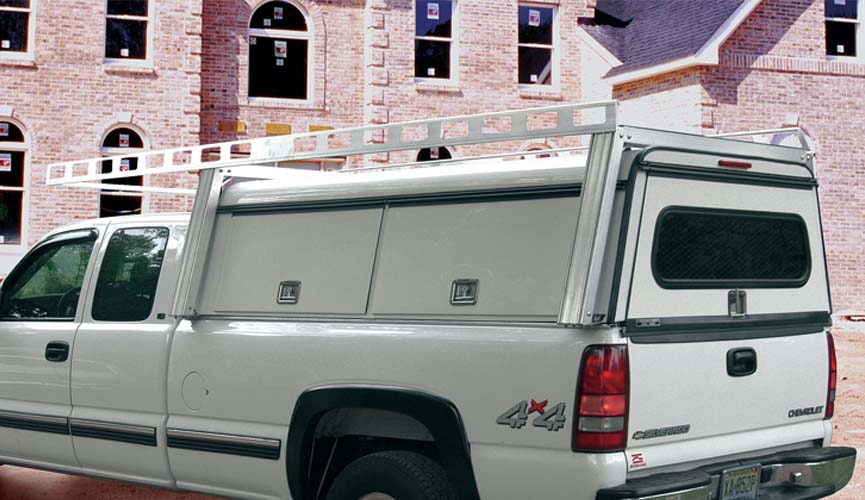

Ladder Racks for Pick-up Trucks with Caps
System One® makes ladder racks to fit around caps. Because the racks mount outside of the cap, and are supported outboard of the truck body, they are called cantilevered racks. Four 3/16" thick stainless steel plates extend outward from underneath the cap and support the weight of the rack and its cargo. These mounting plates, or "cantilever plates", rest on our Pick-up Trak® which serves as a structural foundation that spreads the concentrated loading out along the bed rail instead of directly on the thin sheet metal of the truck bedrail. . This is an extremely important feature missing in most other over-the-cap rack designs. In addition to providing a solid mounting surface for the cantilever plates, the Pick-up Trak®, incorporates a T-slot that runs its entire length inside the cap. This is great for hooks and sliding cargo anchors which help organize and fasten items under the cap. Our over-the-cap, or cantilever racks, are not a "one-size-fits-all-rack." As caps vary in height, so do our racks. Leg lengths for racks are available in 1" increments from 24" thru 34" which accommodate cap heights from cab high to 30" high. Capacities of these ladder racks vary from 600 lbs for cab-high caps to 400 lbs for 30" high caps. Standard gussets are used on almost all cantilevered racks instead of Heavy I.T.S.® gussets so the racks can be built closer to the cap. Heavy I.T.S.® gussets require that the rack be built much taller to allow for the deeper gusset and this resulting taller height not only makes the rack more awkward to load and unload but also reduces its capacity.
Not all caps can be used with cantilevered racks. The following considerations need to be taken into account.
1. Cap height: The cap must be between cab high and 30 inches high. The exact height of the cap is important to provide when ordering.
2. Cap angle: Since the leg angle on our racks is fixed at 17.5 degrees, the cap should have a similar angle to avoid contact between them. Almost all fiberglass caps work great with our rack. Aluminum caps often have more vertical walls than fiberglass caps and so the angle should be measured to make sure that it is compatible with our rack. Call us for assitance with this measurement. We can plot it out and determine its compatibility.
3. Side doors: Side doors are usually not a problem however if they are too long they will interfere with the legs of the rack. To make sure you have no interference between the rack's legs and the cap's side door, measure 5 " back from the front of the bulkhead of the bed and 5" forward from the front surface of the tailgate. This is the space that our legs need to occupy.
4. Inner lip along bedrail: Some fiberglass caps have a lip extending downward from the mounting flange that runs along the inside of the bedrail to center the cap on the pick-up bed. This flange can be difficult to deal with and needs to be completely removed if the cap will be used with our rack.
Note: If the cap is structural, in other words, able to support the weight of a rack with its cargo, it may be better suited for a surface mount rack. Click on "Enclosed Body Racks" for more details. Racks for structural caps can be built as Contractor Rigs® or as Utility Rigs™ and mount directly to the roof's surface. They utilize our I.T.S.® surface mount brackets, which takes advantage of their ability to accept Work Winches®. These racks could also be mounted directly to the roof by omitting the Surface Mount Brackets and utilizing the T-slots in the undersides of the crossmembers. Various height spacers (wood, metal or plastic) can be used between the roof and the crossmembers resulting in a very low profile installation. Both of these methods for mounting racks on steel caps result in an extremely rigid mount.
